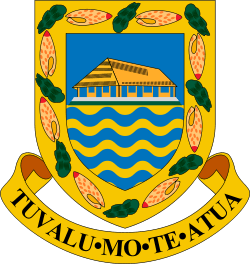Timeline of the history of Tuvalu

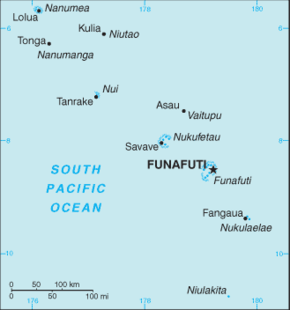
This time line of the history of Tuvalu chronologically lists important events occurring within the present political boundaries of the Pacific island state of Tuvalu. This time line is introduced by the theories as to the origins of the Polynesian people and the migration across the Pacific Ocean to create Polynesia, which includes the islands of Tuvalu.
Theories as to the origins of the Polynesian people
The first inhabitants of Tuvalu were Polynesians so that the origins of the people of Tuvalu are addressed in the theories regarding the spread of humans out of Southeast Asia, from Taiwan, via Melanesia and across the Pacific islands to create Polynesia.[1] There is evidence for a dual genetic origin of Pacific Islanders in Asia and Melanesia, which results from an analysis of Y chromosome (NRY) and mitochondrial DNA (mtDNA) markers);[2] This DNA evidence is supported by linguistic analysis.[3] and archaeological evidence. There is also evidence that Fiji playing a pivotal role in west-to-east expansion within Polynesia.[4]
Lapita archaeological culture
In the archaeological record there are well-defined traces of this expansion which allow the path it took to be followed and dated with some certainty. It is thought that by roughly 1400 BC,[5] "Lapita Peoples", so-named after their pottery tradition, appeared in the Bismarck Archipelago of northwest Melanesia. This culture is seen as having adapted and evolved through time and space since its emergence "Out of Taiwan".
Within a mere three or four centuries between about 1300 and 900 BC, the Lapita archaeological culture spread 6,000 km further to the east from the Bismarck Archipelago, until it reached as far as Fiji, Tonga, and Samoa.[6][7] The area of Tonga, Fiji, and Samoa served as a gateway into the rest of the Pacific region known as Polynesia.[8]
Settlement of Tuvalu and the Polynesian outliers

During pre-European-contact times there was frequent canoe voyaging between the islands as Polynesian navigation skills are recognised to have allowed deliberate journeys on double-hull sailing canoes or outrigger canoes.[9] Eight of the nine islands of Tuvalu were inhabited; thus the name, Tuvalu, means "eight standing together" in Tuvaluan.
The pattern of settlement that is believed to have occurred is that the Polynesians spread out from the Samoan Islands into the Tuvaluan atolls, with Tuvalu providing a stepping stone to migration into the Polynesian Outlier communities in Melanesia and Micronesia.[10][11][12]
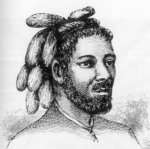
Tuvaluan mythology as to their ancestors is recounted in stories that vary from island to island. On Niutao the understanding is that their ancestors came from Samoa in the 12th or 13th century.[13] On Funafuti and Vaitupu the founding ancestor is described as being from Samoa;[14][15] whereas on Nanumea the founding ancestor is described as being from Tonga;[14] These stories can be linked to what is known about the Samoa-based Tu'i Manu'a Confederacy, ruled by the holders of the Tu'i Manu'a title, which confederacy likely included much of Western Polynesia and some outliers at the height of its power in the 10th and 11th centuries. Tuvalu is thought to have been visited by Tongans in the mid-13th century and was within Tonga's sphere of influence.[15] The extent of influence of the Tuʻi Tonga line of Tongan kings and the existence of the Tuʻi Tonga Empire which originated in the 10th century, is disputed.
The oral history of Niutao recalls that in the 15th century Tongan warriors were defeated in a battle on the reef of Niutao. Tongan warriors also invaded Niutao later in the 15th century and again were repelled. A third and fourth invasion of Tongan occurred in the late 16th century, again with the Tongans being defeated.[13]
Tuvalu is on the western boundary of the Polynesian Triangle so that the northern islands of Tuvalu, particularly Nui, have links to Micronesians from Kiribati.[14] The oral history of Niutao also recalls that during the 17th century warriors invaded from the islands of Kiribati on two occasions and were defeated in battles fought on the reef.[13]
pre-history
| Date | Event |
|---|---|
| 1101 to 1300 AD | The traditions of the people of Niutao, Funafuti and Vaitupu are that their founding ancestors came from Samoa in the 12th or 13th century. The Tu'i Manu'a Confederacy, ruled by the holders of the Tu'i Manu'a title, is understood to have included much of Western Polynesia and some Polynesian outliers. |
| 1201 to 1500 AD | The traditions of the people of Nanumea is that their founding ancestors came from Tonga. The Tuʻi Tonga line of Tongan kings and the Tuʻi Tonga Empire ruled by the Tuʻi Tonga line of Tongan kings was at its height during this period. |
| 1401 to 1600 AD | The oral history of Niutao recalls two invasions of Tongan warriors in the 15th century, when the Tongans were repelled. A third and fourth invasion of Tongans occurred in the late 16th century, again with the Tongans being defeated. |
| 1601-1700 AD | The oral history of Niutao recalls two invasions of warriors from the islands of Kiribati who were defeated in battles fought on the reef. |
1568 to 1900
| Date | Event |
|---|---|
| 16 January 1568 | Álvaro de Mendaña de Neira from Spain sighted the island of Nui, and charted it as Isla de Jesús ("Island of Jesus"). |
| 29 August 1595 | During Mendaña's second voyage across the Pacific he passed Niulakita, which island he named La Solitaria. |
| 1764 | Captain John Byron passed through the islands of Tuvalu during his circumnavigation of the globe as captain of HMS Dolphin. |
| 5 May 1781 | Francisco Mourelle de la Rúa sailed past Niutao. |
| May 1819 | Arent Schuyler de Peyster, captain of the Rebecca, sighted Nukufetau and Funafuti, which he named Ellice's Island after an English Politician, Edward Ellice, the Member of Parliament for Coventry and the owner of the Rebecca's cargo. The name Ellice Islands was subsequently used for all the islands. |
| 1820 | The Russian explorer Mikhail Lazarev visited Nukufetau as commander of the Mirny. |
| May 1824 | Louis Isidore Duperrey, captain of La Coquille, sailed past Nanumanga. |
| 14 May 1825 | A Dutch expedition (the frigate Maria Reigersberg) found Nui atoll and named the main island (Fenua Tapu) as Nederlandsch Eiland. |
| 1841 | The United States Exploring Expedition under Charles Wilkes visited Funafuti, Nukufetau and Vaitupu. |
| 1850s | John (also known as Jack) O'Brien was the first European to settle in the islands, he became a trader on Funafuti. He married Salai, the daughter of the paramount chief of Funafuti. |
| 1861 | Elekana, a Christian deacon from Manihiki in the Cook Islands became caught in a storm and drifted for 8 weeks before landing at Nukulaelae and began proselytising the Christian faith. |
| 1863 | "Blackbirders" enticed about 180 people from Funafuti and about 200 from Nukulaelae onboard ships for transport to work to mine the guano deposits on the Chincha Islands in Peru – they never returned to the islands. |
| 1865 | The Rev. A. W. Murray of the London Missionary Society arrived in the islands as the first European missionary. The work of this Protestant congregationalist missionary society resulted in the Congregational Christian Church of Tuvalu (Te Ekalesia Kelisiano Tuvalu). |
| 16 February 1882 | A tsunami struck Nui. |
| 1883 | A tropical cyclone struck Funafuti destroying all buildings. |
| 1890 | Robert Louis Stevenson, his wife Fanny Vandegrift Stevenson, and her son Lloyd Osbourne visited the islands on the trading steamship the Janet Nicoll. |
| 1891 | A tropical cyclone struck the islands. |
| Between 9 and 16 October 1892 | Each of the Ellice Islands was declared a British Protectorate by Captain Gibson of HMS Curacao. The Ellice Islands were administered as British protectorate by a Resident Commissioner from 1892 to 1916 as part of the British Western Pacific Territories (BWPT) by a Resident Commissioner based in the Gilbert Islands. |
| 1894 | A tropical cyclone struck the islands. |
| 1896 | The Royal Society of London conducts the first of three expeditions to Funafuti to drill into the island for the purpose of investigating the formation of coral reefs. This investigation followed the work on the structure and distribution of coral reefs conducted by Charles Darwin in the Pacific. |
_p405_Platte_Grond_van_het_Nederlandsch-Eiland.jpg) Dutch map of Nui atoll, made in June 1825
Dutch map of Nui atoll, made in June 1825_p297_Het_Nederlandsch_Eiland.jpg) View of Fenua Tapu, Nui atoll
View of Fenua Tapu, Nui atoll_p293_Het_Nederlandsch_Eilanden.jpg) View of Nui atoll
View of Nui atoll
1901 to 1977
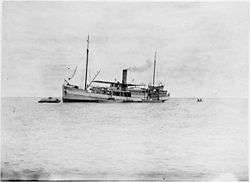
| Date | Event |
|---|---|
| 1905 | The London Missionary Society (LMS) established a primary school at Motufoua on Vaitupu. This school evolved into the Motufoua Secondary School. |
| 1913 | The hospital was established at Funafuti. |
| 1916 | The administration of the BWTP ended and the Gilbert and Ellice Islands Colony was established. |
| 2 October 1942 | United States Marine Corps landed on Funafuti. Naval Construction Battalion (Seabees) built Funafuti Airfield, Nanumea Airfield and Nukufetau Airfield. During the Pacific War the American bases acted as a staging post during the preparation for the Battle of Tarawa and the Battle of Makin that commenced on 20 November 1943. |
| 1947 | Tarawa, in the Gilbert Islands, was made the administrative capital of the Gilbert and Ellice Islands Colony. This development included establishing The King George V Secondary School for boys and the Elaine Bernacchi Secondary School for girls. |
| 1956 | A Colony Conference was organised at Marakei, which was attended by officials and representatives from each island in the Gilbert and Ellice Islands Colony, conferences were held every 2 years until 1962. |
| 1964 | An Executive Council was established to advise the Resident Commissioner. |
| 1965 | Island councils were established with the islanders electing the councillors who then choose the president of the council. The executive officer of each local council was appointed by the central government. |
| 1967 | A Constitution was introduced, which created a House of Representatives for the Gilbert and Ellice Islands Colony that comprised 7 appointed officials and 23 members elected by the islanders. The Ellice Islands elected 4 members of the House of Representatives. The 1967 Constitution also established the Governing Council. |
| 1971 | A new Constitution was introduced in 1971, which provided that each of the Ellice Islands (except Niulakita) elected one representative to the House of Representatives. |
| 21 & 22 October 1972 | Funafuti was severely damaged by Cyclone Bebe. |
| 1974 | Ministerial government was introduced to the Gilbert and Ellice Islands Colony through a change to the Constitution. |
| December 1974 | A self-determination referendum was held to determine whether the Gilbert Islands and Ellice Islands should each have their own administration. |
| 1975 | Students that attended schools on Tawara were transferred to Motufoua Secondary School. |
| 1975 | Princess Margaret Hospital was completed with the financing provided by New Zealand. |
| 1 January 1976 | The Gilbert and Ellice Islands Colony ceased to exist and the separate British colonies of Kiribati and Tuvalu came into existence. |
1978 to 2000
| Date | Event |
|---|---|
| 1 October 1978 | Tuvalu became fully independent within the Commonwealth. |
| 1978 | Tuvalu for the Almighty (Tuvalu mo te Atua) was adopted as the national anthem of Tuvalu. The lyrics and music were composed by Afaese Manoa. |
| 1978 | The Tuvalu Maritime Training Institute was established to train Tuvaluan men for employment on merchant shipping. |
| 1979 | The Tuvalu national football team played international matches in the 1979 South Pacific Games, held in Fiji. |
| 1986 | The Constitution of Tuvalu that was adopted upon independence was revised so that it addressed Tuvaluan customs and traditions as well as the aspirations and values of the Tuvaluan people. |
| 30 January and 1 February 1990 | Cyclone Ofa had a major impact on Vaitupu with around 85 percent of residential homes, trees and food crops being destroyed. |
| 3 to 14 June 1992 | Tuvalu participated in the Earth Summit, United Nations Conference on Environment and Development (UNCED), also known as the Rio Summit or Rio Conference, held in Rio de Janeiro. |
| October 1994 | Pacific-class patrol boat (HMTSS Te Mataili) provided to Tuvalu by Australia under the Pacific Patrol Boat Program for use in maritime surveillance and fishery patrol and for search-and-rescue missions. |
| January 1996 | The Flag of Tuvalu was changed to remove the Union Jack, from the upper left canton of the flag, however the Flag of Tuvalu reverted to the previous design in April 1997. |
| 1998 | Tuvalu first participated in the Commonwealth Games when a weightlifter attended the games held in Kuala Lumpur. |
| 1999 | The Funafuti Conservation Area was created for the conservation of the marine and land based biodiversity (plants, animals and ecosystems) within the protected area. |
| 17 September 2000 | Tuvalu became the 189th member of the United Nations. |
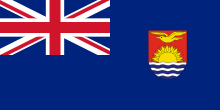
 Flag of the Gilbert and Ellice Islands, of which Tuvalu was a part.
Flag of the Gilbert and Ellice Islands, of which Tuvalu was a part..svg.png)
 Flag of Territory of Tuvalu between October 1, 1976 and October 1, 1978.
Flag of Territory of Tuvalu between October 1, 1976 and October 1, 1978..svg.png)
 Flag of Tuvalu from October 1, 1978 to October 1, 1995.
Flag of Tuvalu from October 1, 1978 to October 1, 1995..svg.png)
 From October to December 1995, Tuvalu slightly changed the flag, reducing the number of stars by one (the flag was a light blue ensign).
From October to December 1995, Tuvalu slightly changed the flag, reducing the number of stars by one (the flag was a light blue ensign)..svg.png)
 Flag of Tuvalu between January 1996 and April 11, 1997.
Flag of Tuvalu between January 1996 and April 11, 1997.
2001 to present
| Date | Event |
|---|---|
| 2003 | The building now occupied by the Princess Margaret Hospital was completed with the building financed by Japan. |
| 30 April 2008 | Tuvaluans rejected a constitutional referendum that proposed replacing the Queen of Tuvalu, with an elected president as the head of state. |
| 2008 | Tuvalu participated in the Olympics Games and sent three athletes to the Summer Olympics in Beijing to compete in the weight lifting and the men's and women's 100 metre races. |
| 2012 | Tuvalu participated in the Olympic Games and sent their top three athletes to the Summer Olympics in London to compete in the weight lift challenge and in both men's and women's 100m sprints. |
| September 2013 | Tuau Lapua Lapua won Tuvalu's first gold medal at the 2013 Pacific Mini Games, when he won the gold medal in weightlifting in the men’s 62 kilogram snatch. (He also won bronze in the clean and jerk, and obtained the silver medal overall for the combined event.) |
| 5 September 2013 | Tuvalu signed the Majuro Declaration, which is an initiative of the Pacific Islands Forum and which is intended to spark a “new wave of climate leadership” and to highlight the impact of climate change in the Pacific Ocean. |
| July 2015 | Telupe Iosefa won Tuvalu's first gold medal at the Pacific Games in the powerlifting 120 kg male division. |
| December 2015 | Tuvalu participated in the 2015 United Nations Climate Change Conference (COP21) in which the participating countries agreed to do their best to keep global warming "to well below 2 degrees C". |
| Part of a series on the |
| Culture of Tuvalu |
|---|
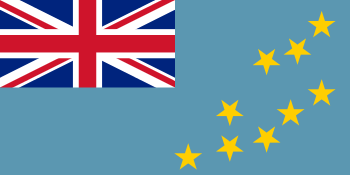 |
| History |
| Languages |
| Cuisine |
| Religion |
| Art |
|
Music and performing arts |
| Sport |
|
Symbols |
|
References and literature
- History
- Tuvalu: A History (1983) Isala, Tito and Larcy, Hugh (eds.), Institute of Pacific Studies, University of the South Pacific and Government of Tuvalu
- Pulekai A. Sogivalu, Brief History of Niutao, A, (1992) Published by the Institute of Pacific Studies. ISBN 982020058X
- Macdonald, Barrie, Cinderellas of the Empire: towards a history of Kiribati and Tuvalu, Institute of Pacific Studies, University of the South Pacific, Suva, Fiji, (2001). ISBN 982-02-0335-X (Australian National University Press, first published 1982)
- References
- ↑ Howe, Kerry (2003). The Quest for Origins. New Zealand: Penguin. pp. 68, 70. ISBN 0-14-301857-4.
- ↑ (2005) "Mitochondrial DNA Provides a Link between Polynesians and Indigenous Taiwanese". PLoS Biology 3(8): e281. doi:10.1371/journal.pbio.0030281
- ↑ "Pacific People Spread From Taiwan, Language Evolution Study Shows". ScienceDaily. 27 January 2009. Retrieved 29 April 2010.
- ↑ "Melanesian and Asian Origins of Polynesians: mtDNA and Y Chromosome Gradients Across the Pacific". Anthrocivitas.net. October 2009. Retrieved 23 January 2014.
- ↑ Kirch, P. V. (2000). On the road of the wings: an archaeological history of the Pacific Islands before European contact. London: University of California Press. ISBN 0520234618. Quoted in Kayser, M.; et al. (2006).
- ↑ Bellwood, Peter (1987). The Polynesians – Prehistory of an Island People. Thames and Hudson. pp. 45–65. ISBN 0500274509.
- ↑ PV Kirch. 1997. The Lapita Peoples. Cambridge: Blackwell Publisher
- ↑ see DV Burley. 1998. Tongan Archaeology and the Tongan Past, 2850-150 B.P. In: Journal of World Prehistory 12:337–392
- ↑ Bellwood, Peter (1987). The Polynesians – Prehistory of an Island People. Thames and Hudson. pp. 39–44.
- ↑ Bellwood, Peter (1987). The Polynesians – Prehistory of an Island People. Thames and Hudson. pp. 29 & 54.
- ↑ Bayard, D.T. (1976). The Cultural Relationships of the Polynesian Outiers. Otago University, Studies in Prehistoric Anthropology, Vol. 9.
- ↑ Kirch, P.V. (1984). The Polynesian Outiers. 95 (4) Journal of Pacific History. pp. 224–238.
- 1 2 3 Sogivalu, Pulekau A. (1992). A Brief History of Niutao. Institute of Pacific Studies, University of the South Pacific. ISBN 982-02-0058-X.
- 1 2 3 Talakatoa O’Brien (1983). Tuvalu: A History, Chapter 1, Genesis. Institute of Pacific Studies, University of the South Pacific and Government of Tuvalu.
- 1 2 Donald G. Kennedy, "Field Notes on the Culture of Vaitupu, Ellice Islands", Journal of the Polynesian Society, vol.38, 1929, pp.2-5
